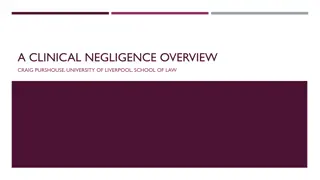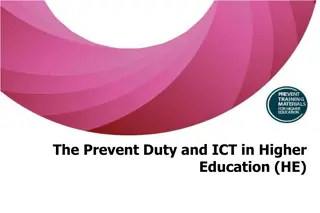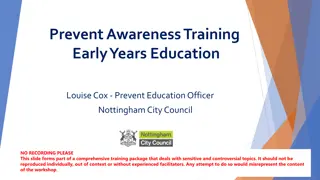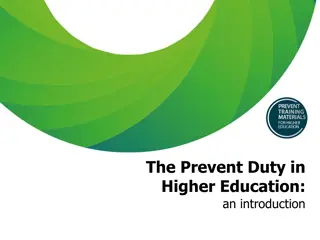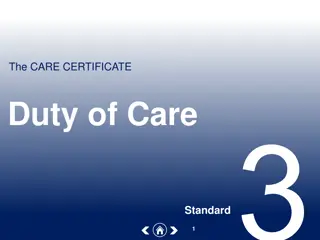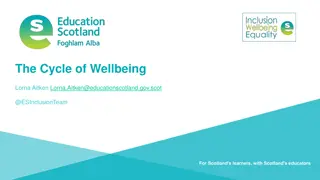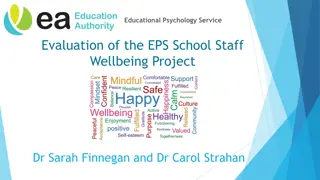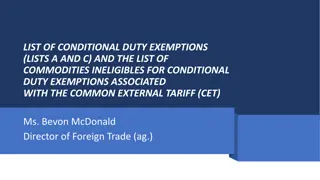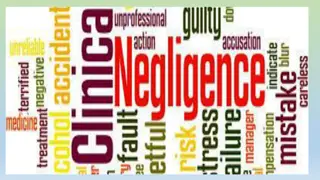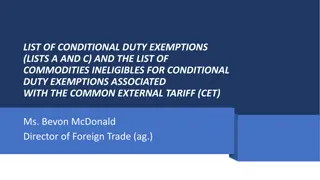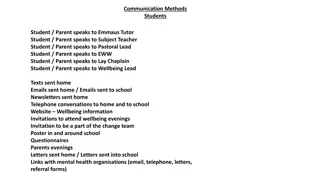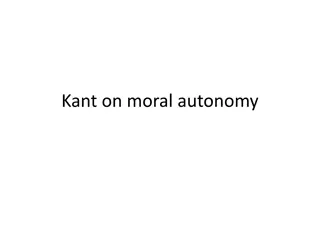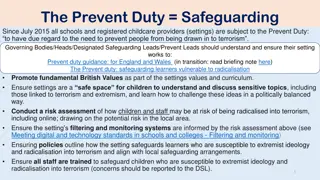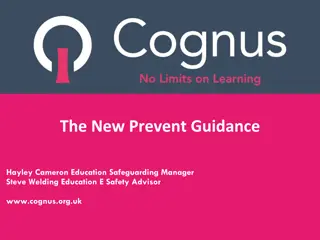Understanding Prevent Duty in Higher Education: Care, Wellbeing & Support
The Prevent duty in higher education requires specified authorities to prevent individuals from being drawn into terrorism. Alongside duty of care, institutions must safeguard staff and student wellbeing while identifying and supporting at-risk students. Effective pastoral care and policies for prayer rooms are essential. The responsibility of relevant higher education bodies is paramount in mitigating risks and promoting a safe learning environment. Clarity is key to avoiding misconceptions and unjust accusations related to counter-terrorism measures.
Download Presentation

Please find below an Image/Link to download the presentation.
The content on the website is provided AS IS for your information and personal use only. It may not be sold, licensed, or shared on other websites without obtaining consent from the author. Download presentation by click this link. If you encounter any issues during the download, it is possible that the publisher has removed the file from their server.
E N D
Presentation Transcript
Prevent: the duty of care and staff/student wellbeing
Outline What does the Prevent duty require of higher education providers? What the Prevent duty expects of us in safeguarding our students and what we seek to avoid Identifying and supporting students at risk What is a duty of care in the context of the Prevent Duty and what is its scope Has the Prevent statutory guidance changed much? Duty to students, staff and visitors
What the duty says (1/2) Duty of care: The statutory obligation for specified authorities including relevant higher education bodies (RHEBs) is to have due regard to the need to prevent people from being drawn into terrorism . [Section 26 CTSA 2015] The term due regard as used in the Act means that the authorities should place an appropriate amount of weight on the need to prevent people being drawn into terrorism when they consider all the other factors relevant to how they carry out their usual functions. [Paragraph 4, Prevent duty in HE guidance]
What the duty says (2/2) Staff and student wellbeing: Welfare and pastoral care and chaplaincy support 25. Relevant Higher Education Bodies (RHEB) have a clear role to play in the welfare of their students and we would expect there to be effective pastoral support and sufficient chaplaincy and available for all students. 26. As part of this, we would expect the institution to have clear and widely available policies for the use of prayer rooms and other faith-related facilities. These policies should outline arrangements for managing prayer and faith facilities (for example an oversight committee) and for dealing with any issues arising from the use of the facilities. [Paragraphs 25/26, HE guidance]
Students at risk Staff and student wellbeing: Students can become at risk for many reasons while they are in higher education We have many ways of supporting students to mitigate those risks Consider for 10 minutes some of the concerns that students may bring to your attention, and what your response would be
Providing clarity (1/2) What we want to avoid: Headlines like: Students accused of being a terrorist for reading a book on terrorism. Questioning of student by Counter-Terrorism police after accessing course reading that had been uploaded to Blackboard by his lecturer, which was also widely reported.
Providing clarity (2/2) What we are not asking of you: Requirements of the duty are on the institution, not the individual. We are not expecting you to make decisions about individuals yourself, without support. Prevent is not about spying on students. External speaker procedures are not about stopping or restricting student events.
Key considerations Need to avoid stigmatising certain groups of students or victimising people with genuine vulnerabilities To prevent students becoming more isolated as a result of fear of being reported Genuine welfare concerns should be addressed, not ignored Chaplaincy services may come under additional scrutiny from students The Prevent duty requires that authorities should place an appropriate amount of weight on the need to prevent people being drawn into terrorism when they consider all the other factors relevant to how they carry out their usual functions. [Paragraph 4, general guidance]
Prevent duty guidance: achieving compliance (1/3) Most of these providers already have a clear understanding of their Prevent-related responsibilities .(and) already demonstrate some good practice in these areas. We do not envisage the new duty creating large new burdens on providers and intend it to be implemented in a proportionate and risk based way. Compliance requires that thought-through policies and procedures are in place (this) will mean that providers are well placed to comply. But compliance will only be achieved if these procedures and policies are properly followed and applied. [Paragraphs 4/5, HE guidance]
Prevent duty guidance: achieving compliance (2/3) Much of this guidance therefore addresses the need for RHEBs to have the necessary staff training, IT policies and student welfare programmes to recognise these signs (of radicalisation) and respond appropriately. [Paragraph 15, HE guidance] RHEBs have a clear role to play in the welfare of their students and we would expect there to be sufficient chaplaincy and pastoral support available to students. [Paragraph 25, HE guidance] Compliance with the Prevent Duty is regulated by the Office for Students
Prevent duty guidance: achieving compliance (3/3) The Statutory Guidance directs RHEBs to consider their approach in a number of key areas: the provision and management of faith related support and prayer facilities the requirement to promote and protect freedom of speech and academic freedom whilst managing potential risks arising from external speaker events consideration of filtering and monitoring of internet use
What is a providers duty of care? The responsibility for safeguarding in higher education is materially different from other educational settings and this is reflected in the different nature of the Prevent guidance for higher education and further education providers. But a duty of care does arise in certain circumstances to students, staff and visitors. Let us look at what these are and assess how the Prevent duty interacts with these.
When can a duty of care arise? Where there is a contractual relationship Where there is a statutory duty (e.g. equality or health and safety) Where there is foreseeability of harm There is a possibility of an enhanced duty of care to vulnerable groups (eg young people or people with a disability).
What level of duty? Making sure that lecturer/counsellor/welfare tutor/support worker is reasonably competent What is reasonable varies with the circumstances Need to keep up to date/refresher courses Be aware of your limitations and know when to refer to the specialist team within the provider. The duty of care means that the institution has to think about and risk assess its activities and take action, which is reasonable in the circumstances, to minimise the risks it has identified. It does not mean that the institution has to guard against every conceivable harm that might arise.
Duty 1 - freedom of speech and external speakers To ensure that freedom of speech and academic freedom within the law is maintained on campus for staff, students and external speakers To ensure the safety of staff, students and visitors at events held on campus or branded events held elsewhere To carry out an effective risk assessments of events To follow policies To have due regard to the need to prevent people from being drawn into terrorism To take reasonable measures at an event to prevent discrimination, harassment and victimisation of anyone .
Duty 2 - towards staff To train relevant staff. To identify which are relevant staff? What level of training reasonable in the circumstances Training to be appropriate and refreshed/ updated Properly thought through policies and procedures. [Paragraph 5, HE guidance] Ensure they are clear, well communicated, with clear lines of authority for decision making Appropriate allocation of decision-making responsibilities. .
Duty 3 - student support Prevent guidance highlights an expectation to provide sufficient welfare and chaplaincy support for all students But not prescriptive in how Usually set out in student contract (in the prospectus, on the web, handbooks, relevant policies and procedures, etc) Must meet expectations set out in contract and staff must use reasonable skill and care in carrying out support. .
Duty 4 - to students under GDPR (an existing statutory obligation) Prevent guidance highlights the need for compliance with the General Data Protection Regulations. [Paragraph 21, general guidance] Training for staff working with students on the restrictions concerning release of information Creation of fair and transparent data sharing agreements with police, NHS, local authorities Students informed when data will be shared None of this is new.
Duty 5 - equality law The revised Prevent guidance for all specified authorities explains the need to implement Prevent in the context of other existing statutory duties It states: The duty is likely to be relevant to fulfilling other responsibilities such as the duty arising from section 149 of the Equality Act 2010. [Paragraph 12, general guidance] Implementation of the Prevent Duty requires careful consideration of a variety of duties and responsibilities balance and proportionality .
When does a breach of duty arise? Where there is a clear duty of care health and safety Where there is a failure to have in place and implement policies and procedures to comply with a statutory duty Where there is a failure to provide levels of support stipulated in the student contract for example support to students with a disability or other known vulnerability When the potential harm is foreseeable and the RHEB has failed to meet a reasonable standard of care in those circumstances .
Risk of litigation Theoretically, a RHEB could face litigation from an individual or family of an individual who was drawn into terrorism because of what happened to them on campus But to be successful there would need to be strong evidence that the institution had failed significantly to implement the Prevent duty And evidence that radicalisation was the result either of action or inaction on the part of the RHEB that caused the loss or injury And that the individual was drawn into terrorism mainly due to influences at the RHEB and over which the RHEB had control .
In summary - student support Utilise the same channels you would normally use to raise a welfare concern about a student Take a proportionate approach Offer support to students in relation to their engagement. .
In summary - duty of care There are circumstances where a duty of care to students, staff and visitors exists These pre-date the Prevent duty and come within the usual functions of the RHEB They are mostly referenced in the Prevent statutory guidance either the guidance to all specified authorities or the specific guidance to HE providers The Prevent duty is a statutory duty but provided it is implemented properly and as set out in the guidance, it does not greatly increase the duty of care owed There is, though, a need to ensure that risk assessments take the risk of litigation into account, however small And it should be noted that this is a matter of legal opinion and ultimately a matter for the courts
Thank you Questions and clarifications


